AUTOSAR Platform research: the pace of spawning the domestic basic software + full-stack chip solutions quickens.
In the trend towards software-defined vehicles, AUTOSAR is evolving towards a more open and cooperative ecosystem.
On December 7, 2023, AUTOSAR released the latest standard AUTOSAR Release R23-11. From a functional perspective, the update focuses on three aspects: information security, functional safety and communication protocol stack.
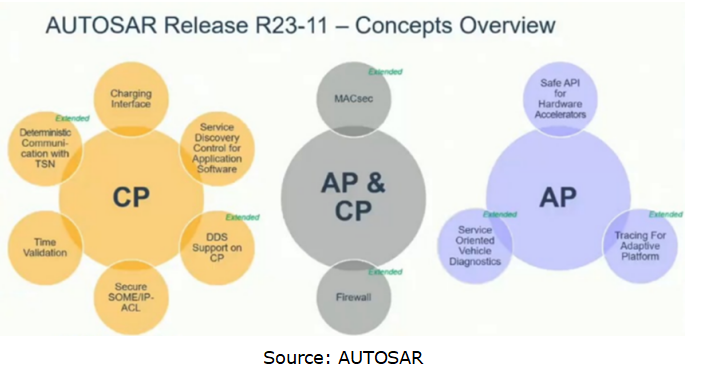
In the Release R23-11, the architecture of AUTOSAR Adaptive Platform (AP) is readjusted, and its functions are reorganized and described. The architecture is re-divided into Foundation, Platform Service, Standardized App/Interface and Vehicle Service.
Wherein, the function components (FC) of Vehicle Service are not required to be deployed on every Machine of the AP, but available within the vehicle. Platform Service is partially responsible for providing specific functions for a single AP Machine; Standardized App/Interface provides standard interfaces or applications; Foundation provides local functions and C++ library of an AP Machine.
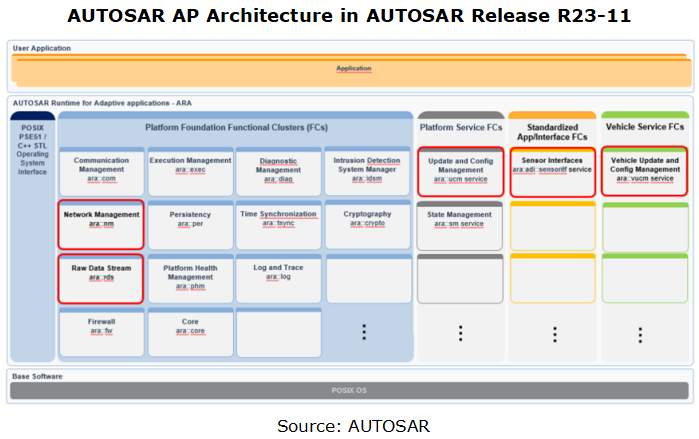
In addition to continuous efforts to upgrade and improve functional standards, AUTOSAR will take a more open attitude and cooperate with other third-party organizations to build a new automotive ecosystem and favor the boom of the intelligent vehicle market, in the face of new trends such as software-defined vehicles.
In March 2023, AUTOSAR, COVESA, Eclipse SDV and SOAFE jointly formed the SDV Alliance, a “collaboration of collaborations”. The main purpose of the collaboration is to align efforts in the SDV ecosystem. By embracing existing descriptions of SDV from each of these efforts, as well as other external organizations, the SDV Alliance will agree on a clear and unified definition of what constitutes an SDV.
The Alliance will then look at the different technologies, methodologies, and standards of each organization and show how they can work together for the development of the SDV. Recognizing that the SDV is conceptually too complex to be handled in a single industry consortium, and by looking at each of the organization’s core competencies and varied execution environments, the Alliance will pool these skills to create a joint SDV vision.
At CES 2024, the SDV Alliance announced its first integration blueprint, contributing to promoting software-defined vehicles.
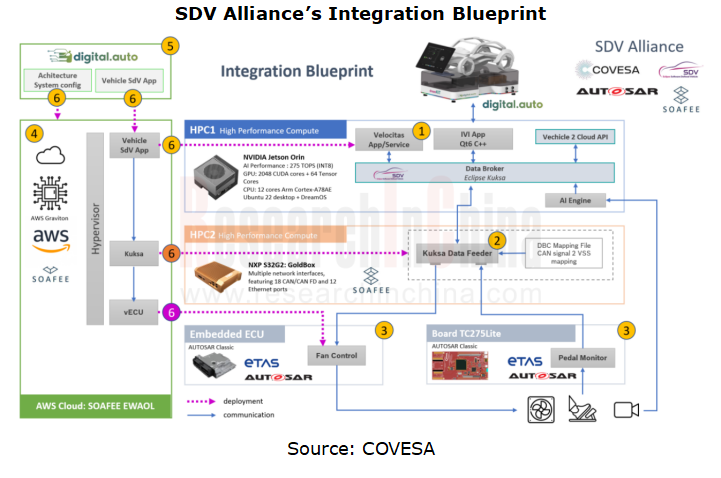
Mass production of intelligent driving solutions based on AUTOSAR AP is increasing.
As autonomous driving domain controllers are spawned and installed in vehicles, supported by solutions of major suppliers, intelligent driving software based on AUTOSAR AP has also achieved mass production and application, and keeps increasing. As well as intelligent driving domain controllers for Volkswagen ID series that use AUTOSAR AP basic software, intelligent driving solutions for multiple vehicle models of Chinese independent brands, like Geely Boyue L and Changan NEVO A05, have also adopted AUTOSAR AP solutions since 2022.

Freetech launched ODIN Digital Intelligence Base, a domain control solution that includes FAS, its self-developed autonomous driving software platform. FAS, middleware self-developed on hardware driver, contain standard middleware AUTOSAR CP and AUTOSAR AP and non-standard middleware FTZen (FTZen Middleware System), and enables EM management, status machine management, EOL, communication management and data services, node services and so on. Accordingly, the FAS toolchain also provides configurations for AP, CP, and non-standard middleware.
Based on ODIN Digital Intelligence Base, Freetech has launched multiple domain controller products such as ADC 15, ADC 20, ADC 25 and ADC30, and has mass-produced them.
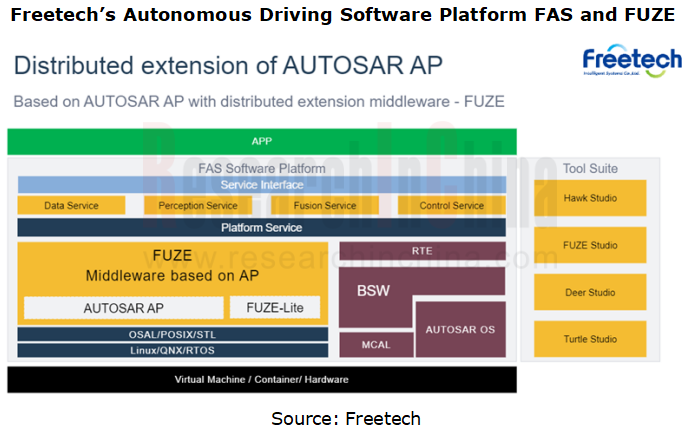
AUTOSAR attracts increasing attention in the Chinese market, and localization is accelerating.
Driven by the boom of intelligent vehicles in China, AUTOSAR catches the increasing attention of the Chinese market, specifically:
First, AUTOSAR works hard on layout in the Chinese market. In 2022, the organization established China Center in the country. By organizing AUTOSAR-related public training, cooperating with universities, and holding AUTOSAR open conferences, it makes greater efforts to promote and improve its services in the Chinese market.
Moreover, the number of AUTOSAR’s Chinese members is increasing, and they have a bigger say. The number of AUTOSAR’s members in China increased from 21 in 2019 to over 60 in 2023, and Neusoft Reach, iSoft, Jingwei HiRain are all its premium partners. In 2023, Huawei became AUTOSAR’s Premium Partner Plus (there are only three worldwide, and the other two are Vector and Denso). Premium Partner Plus need to send a Project Leader to participate in management of formulation of AUTOSAR standards, and co-decision on standardization, In the future, ever more Chinese voices will be heard in formulation of AUTOSAR specifications.
Second, in China there are increasing software vendors using AUTOSAR. Neusoft Reach, iSoft, Jingwei HiRain, Huawei, Baidu, EnjoyMove Tech, HoloMatic Technology, Freetech, Novauto, Hinge Tech, Zhicong Technology, and CICV among others make product layout in line with AUTOSAR standards.
Third, in the trend towards localization of automotive chips and OS in China, AUTOSAR software vendors vigorously adapt to domestic MCUs and other chip products, accelerating mass production and application of Chinese full-stack solutions. Under the wave of localization of basic software and chips, there is an increasing demand for independent R&D of automotive software platforms. In China, AUTOSAR-based software development has also transitioned from the "introduction phase" to the "application phase", and will enter the "innovation phase" in the future, absorbing the quintessence of AUTOSAR and empowering independent automotive software development. In recent years, quite a few basic software vendors have worked on adaptation to domestic MCU and OS products to accelerate the mass production of domestic solutions and application in vehicles.
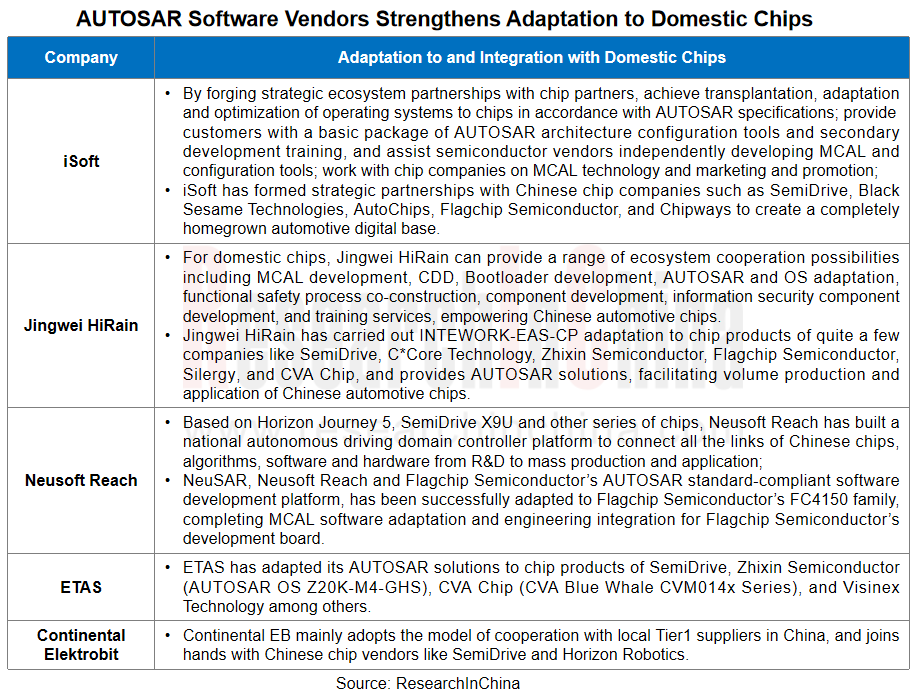
Finally, factors including intelligent vehicle development and policies will bring the opportunities of domestic replacement of AUTOSAR, especially in the field of intelligent driving.
With the rapid iteration of EEA, a unified standard for intelligent driving basic software middleware has yet to form. Currently AUTOSAR AP is one of the options, and many OEMs or suppliers with software strength, such as Technomous, Zuxia Technology and IMotion Automotive Technology, will choose to self-develop middleware products.
Autonomous Driving Domain Controller and Central Computing Unit (CCU) Industry Report, 2025
Research on Autonomous Driving Domain Controllers: Monthly Penetration Rate Exceeded 30% for the First Time, and 700T+ Ultrahigh-compute Domain Controller Products Are Rapidly Installed in Vehicles
L...
China Automotive Lighting and Ambient Lighting System Research Report, 2025
Automotive Lighting System Research: In 2025H1, Autonomous Driving System (ADS) Marker Lamps Saw an 11-Fold Year-on-Year Growth and the Installation Rate of Automotive LED Lighting Approached 90...
Ecological Domain and Automotive Hardware Expansion Research Report, 2025
ResearchInChina has released the Ecological Domain and Automotive Hardware Expansion Research Report, 2025, which delves into the application of various automotive extended hardware, supplier ecologic...
Automotive Seating Innovation Technology Trend Research Report, 2025
Automotive Seating Research: With Popularization of Comfort Functions, How to Properly "Stack Functions" for Seating?
This report studies the status quo of seating technologies and functions in aspe...
Research Report on Chinese Suppliers’ Overseas Layout of Intelligent Driving, 2025
Research on Overseas Layout of Intelligent Driving: There Are Multiple Challenges in Overseas Layout, and Light-Asset Cooperation with Foreign Suppliers Emerges as the Optimal Solution at Present
20...
High-Voltage Power Supply in New Energy Vehicle (BMS, BDU, Relay, Integrated Battery Box) Research Report, 2025
The high-voltage power supply system is a core component of new energy vehicles. The battery pack serves as the central energy source, with the capacity of power battery affecting the vehicle's range,...
Automotive Radio Frequency System-on-Chip (RF SoC) and Module Research Report, 2025
Automotive RF SoC Research: The Pace of Introducing "Nerve Endings" such as UWB, NTN Satellite Communication, NearLink, and WIFI into Intelligent Vehicles Quickens
RF SoC (Radio Frequency Syst...
Automotive Power Management ICs and Signal Chain Chips Industry Research Report, 2025
Analog chips are used to process continuous analog signals from the natural world, such as light, sound, electricity/magnetism, position/speed/acceleration, and temperature. They are mainly composed o...
Global and China Electronic Rearview Mirror Industry Report, 2025
Based on the installation location, electronic rearview mirrors can be divided into electronic interior rearview mirrors (i.e., streaming media rearview mirrors) and electronic exterior rearview mirro...
Intelligent Cockpit Tier 1 Supplier Research Report, 2025 (Chinese Companies)
Intelligent Cockpit Tier1 Suppliers Research: Emerging AI Cockpit Products Fuel Layout of Full-Scenario Cockpit Ecosystem
This report mainly analyzes the current layout, innovative products, and deve...
Next-generation Central and Zonal Communication Network Topology and Chip Industry Research Report, 2025
The automotive E/E architecture is evolving towards a "central computing + zonal control" architecture, where the central computing platform is responsible for high-computing-power tasks, and zonal co...
Vehicle-road-cloud Integration and C-V2X Industry Research Report, 2025
Vehicle-side C-V2X Application Scenarios: Transition from R16 to R17, Providing a Communication Base for High-level Autonomous Driving, with the C-V2X On-board Explosion Period Approaching
In 2024, t...
Intelligent Cockpit Patent Analysis Report, 2025
Patent Trend: Three Major Directions of Intelligent Cockpits in 2025
This report explores the development trends of cutting-edge intelligent cockpits from the perspective of patents. The research sco...
Smart Car Information Security (Cybersecurity and Data Security) Research Report, 2025
Research on Automotive Information Security: AI Fusion Intelligent Protection and Ecological Collaboration Ensure Cybersecurity and Data Security
At present, what are the security risks faced by inte...
New Energy Vehicle 800-1000V High-Voltage Architecture and Supply Chain Research Report, 2025
Research on 800-1000V Architecture: to be installed in over 7 million vehicles in 2030, marking the arrival of the era of full-domain high voltage and megawatt supercharging.
In 2025, the 800-1000V h...
Foreign Tier 1 ADAS Suppliers Industry Research Report 2025
Research on Overseas Tier 1 ADAS Suppliers: Three Paths for Foreign Enterprises to Transfer to NOA
Foreign Tier 1 ADAS suppliers are obviously lagging behind in the field of NOA.
In 2024, Aptiv (2.6...
VLA Large Model Applications in Automotive and Robotics Research Report, 2025
ResearchInChina releases "VLA Large Model Applications in Automotive and Robotics Research Report, 2025": The report summarizes and analyzes the technical origin, development stages, application cases...
OEMs’ Next-generation In-vehicle Infotainment (IVI) System Trends Report, 2025
ResearchInChina releases the "OEMs’ Next-generation In-vehicle Infotainment (IVI) System Trends Report, 2025", which sorts out iterative development context of mainstream automakers in terms of infota...